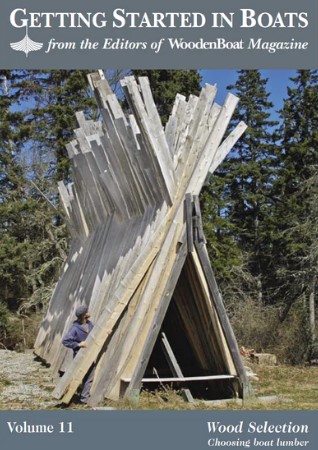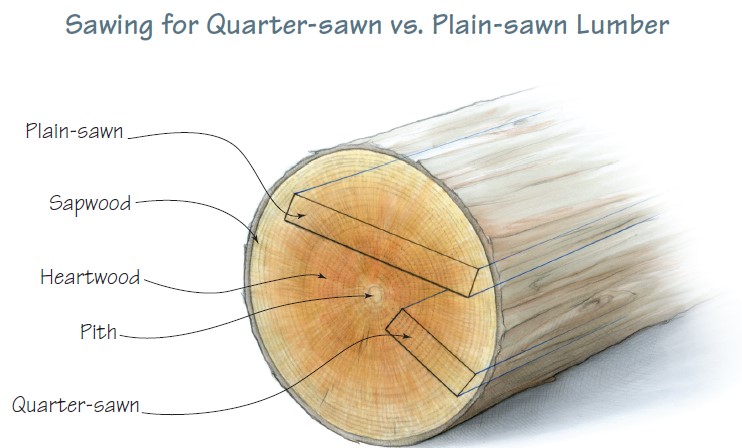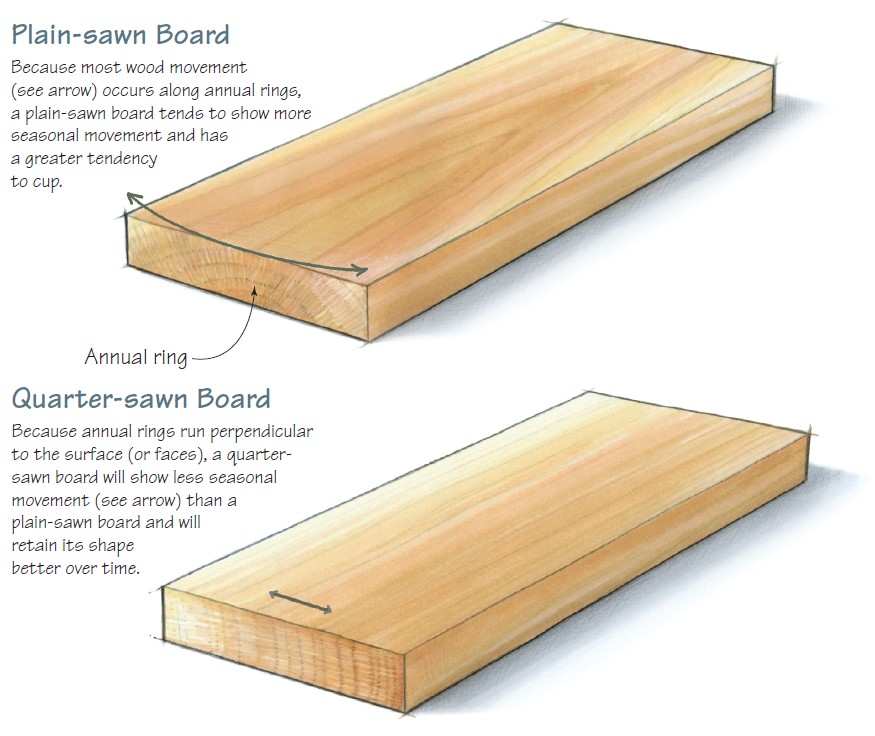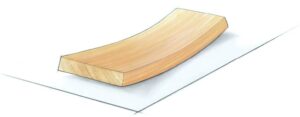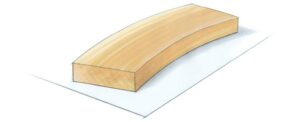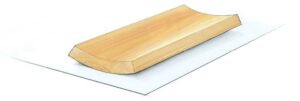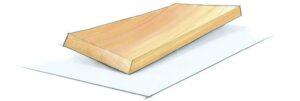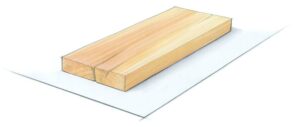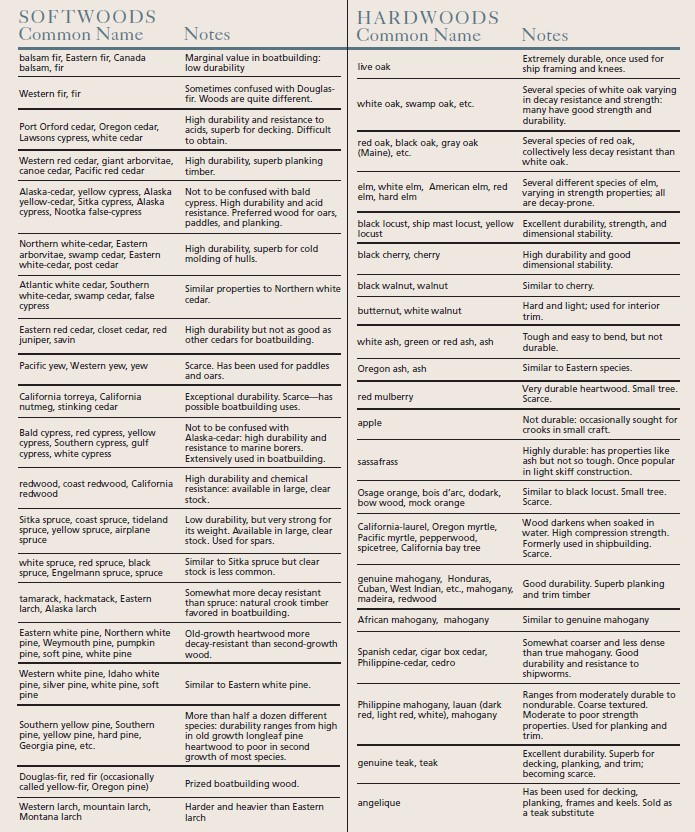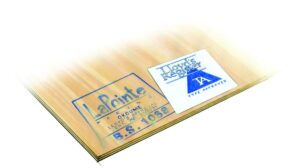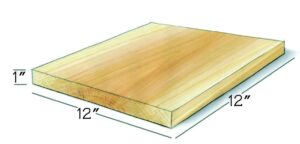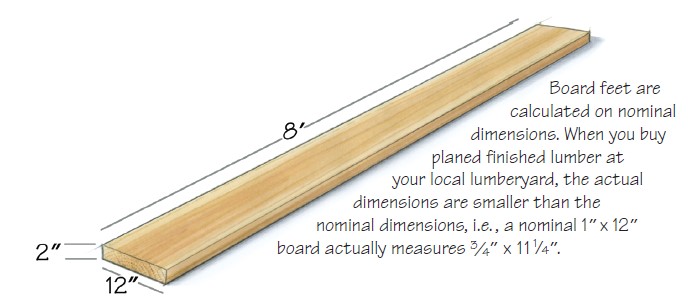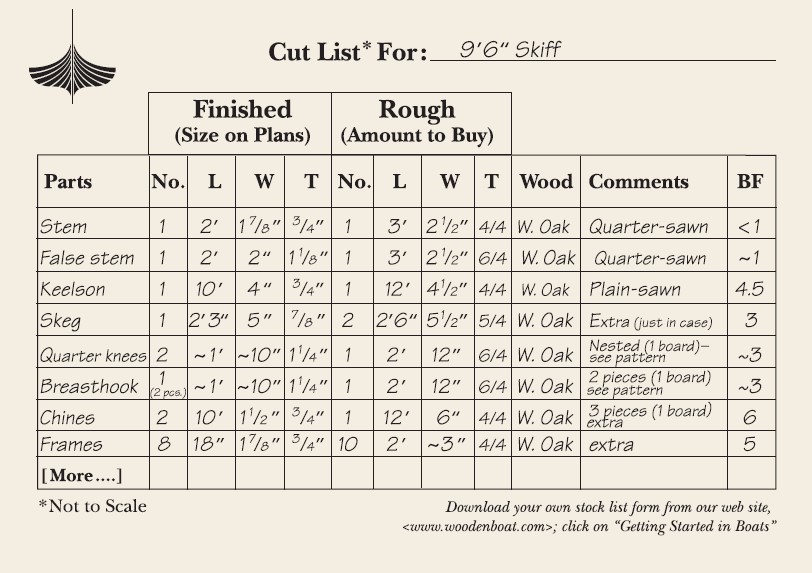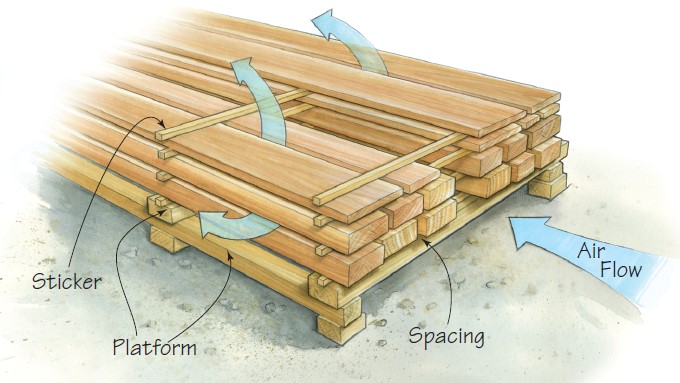Wooden boat building is different from any other form of woodworking. It requires curves and angles rarely found in furniture and house construction. Boats are structures that move. Because a boat spends much of its life in water, the wood used to build it must have certain properties that give it sufficient strength, make it resistant to rot, and provide resiliency when used in conjunction with fastenings, adhesives, and day-to-day use. So, as you begin to look at boatbuilding wood, there are certain things you’ll need to know.
In this issue of Getting Started, we’ll examine important characteristics of wood, look at some of the wood species and plywood types used in boatbuilding, and give you some pointers on how to create a stock list. This article is limited to wood selection, so you won’t see processes such as milling, machining, or working wood covered here. This overview, we hope, will help you select the best material for your project and help you to get the most out of every board foot.
Wood Basics
When selecting wood, it’s important to consider dimensional stability. Dimensional stability refers to how much a board shrinks or swells. One way that sawyers can help assure some level of dimensional stability is by taking cuts in the log that best utilize its growth-ring pattern for minimizing shrinkage and swelling.
What to Look for in Boat Lumber
Quarter-sawn lumber will have good dimensional stability across its face. It is usually considered the prime cut and, as such, costs more than the other cuts. Plain-sawn (or flatsawn) wood will have a tendency to cup and, over time, it will appear as if growth rings are trying to flatten out. Quarter-sawn wood is good to have in some boatbuilding applications, such as planking below the waterline, where swings in shrinkage and swelling are greater than they are on the remainder of the hull. Plain-sawn wood is suitable for planking and other components in small boats. Heartwood (the older part of the tree) is often more durable than sapwood (the outer rings in the living tree). Sapwood of any species is considered non-durable. Some boatbuilders shy away from using sapwood, others do not. Personally, I am less inclined to use it unless I can place it well above the waterline.
More Terminology
Here are some characteristics and terms commonly used when dealing with boatbuilding lumber; the first four have to do with warping.
Bow—Curve along the face of a board from end to end, like a rocker at the base of a rocking chair.
Crook—The end-to-end curve (warp) along a board’s edge. Not to be confused with this form of warp is the term crook timber, also known as compass timber (and often referred to as “a crook”), which is sawn from the roots and branch crotches of trees. The natural curvature of crook timber makes strong and beautiful stems, breasthooks, and quarter knees.
Cup or Cupping—Curve along the width of a board from side to side. Cupping is the result of uneven drying. Using even slightly cupped wood on a table saw heightens the danger of the operation because it can lead to a pinched blade and kick-back. If cupped wood must be used, I favor cutting with a bandsaw, as it is less likely to cause harm. When cutting cupped wood on a bandsaw, be sure to place the board cupped-side-down on the worktable (as a frown) for better stability while you work.
Twist—An uneven warping that makes the board appear to be spiraling. This defect is a dangerous one to mill, a difficult one to correct, and should be avoided if possible.
Checks or Checking—Cracks in the wood, usually found at board ends and sometimes found in the middle of the board. Checking can be a result of uneven drying, living tree shakes, or mishandling (dropping). Look carefully at boards that have checks. While checks may appear to be only a few inches long (and many are), they might indicate a major weakness along the board’s length.
Pitch Pocket—A pitch pocket is an opening between the growth rings that now holds, or did hold, resin.
Live Knot— Live knots (also known as tight or red knots) are so named because they were alive when the tree was harvested. They are more firmly attached to the board than dead knots. Since they usually are not rotten, they can sometimes be left alone rather than drilled out and plugged.
Dead Knot, Loose Knot, Black Knot— Dead, loose, or black knots are from a branch that was dead at the time of harvest. These are dark, rotten, and usually loose or easy to loosen and should be removed. They’ll leave a dark hole that should be reamed free of residue and then plugged.
Four-quarter (4/4)—A way of describing stock according to the number of “quarters” or quarter-inches in its thickness. Boards that are 1″ thick are referred to as four-quarter (4/4) stock. Five-quarter (5/4) stock is 11⁄4″ thick; six-quarter (6/4) stock is 1 1⁄2″ thick; eight-quarter (8/4) lumber is 2″ thick. Expect these to be rough-sawn dimensions, especially if wood is purchased from a lumberyard. Finished wood denoted as 4/4 will actually be somewhat thinner than an inch. So, if you need wood that is truly 1″ thick, you’ll need to buy rough stock that is 5/4.
Rough or Rough-sawn Lumber—Wood that has not yet been planed to finished thickness.
Finished Thickness—Wood that has been planed to its final thickness and is ready for the project at hand.
Wood Species
Dr. Richard Jagels, professor of forest biology at the University of Maine in Orono and a regular contributor to WoodenBoat , prepared the following list of wood species that are often used in boatbuilding. It should be noted that the advent of strip-building has opened new frontiers to small-boat builders. Often used to construct canoes and kayaks, this process usually includes gluing together long, thin strips of wood on a mold into a hull shape and then encapsulating it with fiberglass cloth and epoxy. Woods such as walnut, basswood, and a variety of other species that are not traditionally thought of as boatbuilding (or at least hull-building) woods are now regularly used for strip-planking. They offer new options and color choices for small-boat construction.
Plywood
Plywood continues to gain in popularity among boatbuilders, especially those who build small boats. Chief among the reasons are its dimensional stability and its availability. It is also becoming increasingly difficult to find natural wood that is wide enough for some planking. For example, in building a traditional skiff, it is not uncommon to need a 14″ – wide board for the garboard (lowermost) strake. Also, plywood is more split-resistant, often outperforming even a properly steamed natural plank.
Some plywood is not suitable for use in a marine environment. To assure that yours is, you’ll need to look at its rating.
One basic classification to look for is B.S. 1088. The B.S. stands for “British Standard”—an acknowledged standard-setting entity. The “1088” is their best-known designation for marine plywood that is suitable for small-boat and pleasure-boat building. It is manufactured with waterproof glue and has a very limited number of small voids. An additional assurance that your plywood meets these standards comes from Lloyd’s Register. The Lloyd’s sticker on the sheet indicates that, in addition to meeting the British Standard, the manufacturers have placed themselves under the scrutiny of Lloyd’s and have agreed to meet with their standards. B.S. 1088 with the Lloyd’s sticker is more costly than the rest—but many builders feel that it’s worth it. When you consider how little the cost of materials is in the scheme of building a boat (time in labor is the greatest expense), I would agree with them. When you shop for plywood, make sure that it meets B.S. 1088 or a comparable standard.
Another factor to consider is the boat’s intended use. Our technical projects manager and resident boatbuilder here at WoodenBoat, Tom Hill, says, “When I build a small boat that needs to be lightweight but can be stored in a garage, I use okoume. It is easy to work and it takes paint well. When weight is less of a concern and I need the boat to be highly rot and abrasion resistant, like when I’m building for an owner who plans to moor his boat all season, then I’ll use sapele.”
When looking for marine plywood, it’s important to ask questions. Reputable dealers will help you, even if you don’t wind up buying from them. To learn more about marine plywood, I encourage you to read Chris Kulczycki’s article on the subject in WB No. 174.
Calculating Board Footage
Board feet” is a way to express lumber volume. One board foot is equal to 144 cubic inches of wood. To find board footage of an amount of wood, we multiply the thickness (in inches) x the width (in inches) x the length (in inches) and divide it by 144 .
So, for our 1 BF we have:
1″ x 12″ x 12″ = 144 cubic inches
144 cubic inches /144 = 1 BF
Now let’s look at a more complex scenario. Here we have a board that is 2″ thick x 12″ wide x 8′ long. First, let’s convert the length measurement into inches. Now we have:
2″ x 12″ x (8′ x 12″ [per foot]) = 2,304 cubic inches
then
2, 304 cubic inches /144 = 16 BF
Making a Stock List
Whether you plan to purchase your wood or go out and harvest it yourself, it’s a good idea to begin your planning by making a stock list (aka: cut list). It may take some time, but in the long run having an accurate stock list will be a big help in estimating costs, and it will guide you in your selection of stock.
The chart has spaces for the individual pieces, the number of pieces needed, their finished dimensions, rough dimensions, wood type (species or plywood type), comments (such as notes or sources), and board feet (BF). You can easily make a chart by hand or on your computer, or you can download one from our web site <www. woodenboat.com> (click on “Getting Started in Boats”).
Begin by looking at your plan. List the names of each piece in the stock list. Some people like to list items according to their building sequence. I prefer to list them according to wood species used. Then, put in the finished dimensions of each piece. Depending upon the level of detail given in your plan, you may need to do some “guesstimating.”
Details such as finished plank lengths can be difficult to pick up from the plan since they are either foreshortened or don’t go in a straight line in every view. Planking presents other special challenges, too. The forward part of the plank may be wider than the aft section. This is often the case with the garboard plank on a traditional skiff. This type of plank may be built out of two boards of different widths. If you choose to do this, make a note of it on the stock list and account for the added length that will be needed to join the two boards together with a scarf joint (a long, tapered joint between two long pieces of wood). Once you have determined the overall finished lengths of your planks and plank pieces, add two to three feet to the overall hull length (rough dimensions) to allow for bending and clamping. Do the same for other long components.
Also note which pieces, such as quarter knees, can be nested (almost like interlocking pieces) or configured around a knot and cut from the same board. I find it helpful to make a sketch of how these could be laid out and what type of board and grain pattern is best.
Finally, in tallying your stock list, you’ll need to add extra BF to account for waste and defects. Are you sitting down? For planking, especially if your stock is live-edged (with the bark still on it), has sapwood, and a lot of defects, plan on over-buying by as much as 100%. For other pieces, plan on buying 30–50% more wood than you think you’ll need.
Locating and Storing Wood
Locating wood—Finding wood for boatbuilding can be a challenge, especially for people who live far from where it is harvested. Unlike the species needed for house construction or furniture making, boatbuilding woods are rarely carried by lumberyards. Get to know a local sawyer, if possible. Lumberyards and big-box stores can be a good place to buy interior or exterior grade plywood (non-marine use), or medium- density fiberboard (MDF) for building jigs and molds. Occasionally, you can even find wood for components like thwarts.
Finally, I’d be remiss if I didn’t mention that one excellent source for locating boatbuilding wood and specialty lumberyards is the classified ad section of the magazine you are now reading.
Storage—The cover photograph for this issue of Getting Started shows how we store white cedar planking stock at WoodenBoat School here in Brooklin. This idea came to us from Harry Bryan, a popular instructor at the WoodenBoat School and a contributing editor to this magazine. While a practical and ingenious idea, most people don’t have the room or the need for this much lumber. The illustration above depicts a method that will work for just about anyone.
Distribute your lumber by weight. Place the largest, thickest pieces at the bottom of the stack. Don’t forget to place stickers under the bottom-most pieces. Make sure that there is at least a finger’s-worth of space between boards that are placed next to one another. Follow this procedure as you place each (progressively lighter) layer of wood on the stack.
Whether your wood is home-harvested or an online purchase, the quest to find boatbuilding lumber shouldn’t feel like a trip to the woodshed. We hope that we have provided you with some new insights so that you’ll know what to look for (and look out for) when selecting wood for your next project.
Karen Wales is associate editor of WoodenBoat. She thanks Dick Jagels for his contributions to this article.
Further reading: Considered the preeminent source in the United States, “Wood Handbook: Wood as an Engineering Material” from the USDA Forest Products Laboratory in Madison, Wisconsin.

